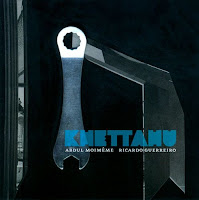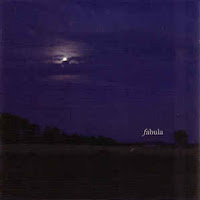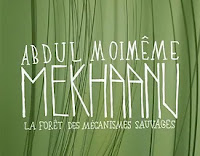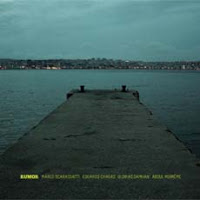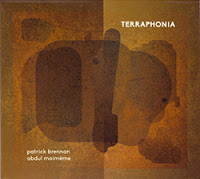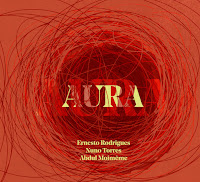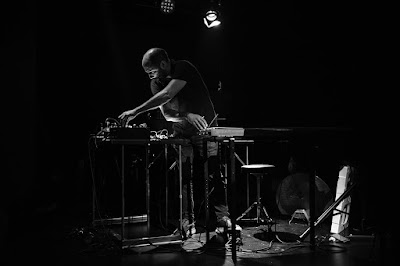 |
| Abdul Moiméme. Photo (c) Nuno Martins |
Introduction
By Paul Acquaro
This past summer, late July to be more precise, I had a partial chance
encounter with guitarist/sound sculpture Abdul Moimême outside of the Jazz Messengers record shop in Lisbon. I say ‘partial’
because we had been in touch about his latest recordings and had made loose
plans to meet up during the Jazz em Agosto festival. This turned out to be
one of several impromptu meet-ups we had during the week, the rest at an
outdoor cafe after the evening concerts.
Going back a bit further, my first encounter with Moimême, and his music, was
at Jazz em Agosto in 2019. He
performed in a hall with a set up where the audience was seated over the
performer, a bit like a lecture hall, a bit like a surgical theater. I
remember being intrigued and a bit confused. Going back to the sentences I wrote about the performance:
It’s a microscopic moment blown up into a 45-minute expose, where all the
vibrations, magnetization, and charge of a strummed chord on an electric
guitar is turned inside out as the audience follows the note through the
wires and out the speakers. Or, rather, as a fellow I spoke with after the
show described, “it’s like we are ants in a universe of sound.”
On the landing outside the record shop, amongst the fantastic open steel staircases and exposed gangways, on
the second level of a bookshop inside an old industrial building in Lisbon’s LX Factory, we spoke about the record that Moimême had just picked-up. If
I recall correctly is was Joe Pass’ For Django – a must hear for any guitarist, any musician, or really, anybody. I suspected the was already quite well aware of the album, but such a treasure on 180
gram vinyl cannot be easily passed up. I likely recalled a story about when a friend and I ‘snuck’ to a jazz bar (we weren’t yet 21) in New Jersey and saw Joe Pass play shortly before he passed away, and then about a guitar I built when I was in high school, an
electric that looked good but whose intonation was a bit um …
crude. I called it the “More or Less Paul.” The conversation shifted to Moimême’s art as he described how he had
also built his instruments, the guitars that he lays flat on the table and he uses to perform and
record.
 |
Photo (c) Nuno Martins |
The conversation slowly turned into a plan, but as it often goes with a plan, it
was interrupted by a few things unplanned, however now, finally, in the budding
moments of 2023, here it is. Over the past two days, Stuart Broomer and I reviewed two of Moimême’s recent works, Ciel-Cristal and Livro das Grutas and what follows here is an account written by Moimême about his life, influences and music. He takes quite a wide view,
looking at traditions of music from both historical and personal
perspectives. This is followed by an annotated discography, with comments from both Moimême and me.
***
Abdul on Abdul
By Abdul Moimême
Early years:
I was born in the heart of Lisbon, but at the age of 3 my family moved to
New Mexico. At age 5 we moved to Dublin, where I began school, studying the
English language alongside Irish. At age 9 my family moved to Madrid where
I completed English secondary school, during the turbulent years that
elapsed between the Portuguese ‘Carnation Revolution’ and the conclusion of
Spain’s drawn-out and agitated transition into Democracy. Though we lived
in Madrid, my holidays were spent in Portugal, which implied living in two
totally contrasting worlds; the repressive governance of the latter-day
Franco regime and, contrastingly, the euphoric and unbridled freedom of
the early Portuguese revolutionary process, which culminated in our current
Democratic regime.
Transition:
During the days of the ancien régime, music was both a means of resistance,
as well as a way of attaining a modest degree of freedom. I believe the
title of the Jazz em Agosto festival, in
its 2019 edition, Resistance, somewhat echoes the spirit of that
time. After all, the code that unleashed the ‘Carnation Revolution’ and the
demise of the Portuguese dictatorship was basically a protest song, played
on the radio; Grandola Vila Morena, to which Charlie Haden’s Liberation Music Orchestra paid a beautiful tribute. This to say
that, for me, very early on, music and especially improved music, became an
existential and aesthetic necessity of the utmost urgency.
Movida:
Alongside both of these major political and social changes came an ample
exposure to live jazz, as both countries began to frequently promote
concerts and festivals. For me, some of the highlights in those years were
(literally) sitting beside Bill Evan’s piano, during his stellar
performance at Madrid’s Balboa Jazz Club, as well as listening to
the Jazz Messengers playing totally acoustic, as the minute size of the
same club so permitted. This was in the Madrid of the early Pedro
Almodovar’s films and La Movida Madrileña, the counterculture
movement that was to rock the very foundations of Spain’s intrinsically
reactionary society.
During this period, I moved to Boston for a year, to begin college; living
in Lexington, with a group of jazz musicians, which included pianist Bruce
Torff. Though at the time I wasn’t actively playing music, I was exposed to
the prolific scene there, topped off with the odd trip to New York’s jazz
and rock clubs.
In 1983, after two decades of living abroad, I made Lisbon my permanent
residence, where I concluded my degree; living for a short period in the
Azores islands, where I began my career as a professional architect.
Musical background:
My itinerant life inevitably had an impact on my interest and approach to
music. The necessity of adapting to regularly changing environments, as
well as being exposed to different cultures, not only broadened my tastes
as it also directed me toward improvisation, as if it were an inevitability
of my own fate. Though many genres of music were played in my house,
essentially, I discovered jazz and contemporary ‘classical’ music on my
own.
I started learning the guitar at the age of 11, with a private teacher;
later studying with her brother, Raul, a proficient flamenco and rock
guitarist. With him I studied both genres. At the time flamenco was
evolving from its traditional form, incorporating rock and other styles of
music into its lexicon. Around that period, Paco de Lucia released his
album Fuente y Caudal, which incorporated electric bass; the very
same year Santana brought his Welcome album tour to Madrid’s Monumental Theatre. I was a young adolescent and very impressed by
the latter’s band. By then, I had already worn out the grooves of Caravanserai and Axis: Bold as Love. In those formative
years such LP releases as George Benson’s Body Talk, Jim Hall’s Jim Hall, Live!, Anthony Braxton Five Pieces, Pat
Metheny’s Bright Size Life and Miles Davis’ Aragtha were
soon to suffer the same fortune.
As far as influences are concerned I am wary of acknowledging any, merely
because it implies assuming the responsibility of a legacy; something I
refuse to invoke light-heartedly. Besides, one tends to idealize one’s own
work beyond realistic proportions. Contrarily, I acknowledge that the
musicians with whom I have played have influenced me greatly.
Essentially, I consider myself a ‘street musician’.
Approach:
The reason I became aware of the electric guitar as a very distinct
instrument, as compared to the Spanish guitar, was the moment I discovered
notes could be prolonged indefinitely by positioning the guitar in a
certain spatial relationship to the amplifier. I’m talking about the kind
of sustain Carlos Santana used to achieve simply with guitar and amp, with
no added electronic effects. It took me a long time to realize how that
simple physical phenomenon could open so many doors and help me sculpt my
particular sound. Amplification became much more than an accessory of the
guitar; it became an integral part of the instrument, modulating the
vibration of the guitar’s strings in an array of possible forms.
It took me many years to really begin to fully explore these possibilities,
something which has become an ongoing work in progress. It has come to the
point where I have a metallic bar that attaches the guitar stand to the
speaker. Laying the guitar horizontally also allowed me to use gravity as a
technical resource, permitting me to constantly shift approaches and
discover new techniques; though technique is only but a means to an end.
For me, the most interesting musicians are those capable of subjugating
their skills to the critical reflection of what makes a sound meaningful.
Only recently have I begun to incorporate electronics. Previously I only
relied on straightforward amplification. Though it sounded like electronic
music the only electronics involved were various stages of
pre-amplification and amplification; the bulk of my sound palette relying
solely on objects and the way I ‘prepare’ the guitar with them.
Although I acquired my first electric guitar when I was 16, a 1973 Fender
Stratocaster which I still have, in the same year I decided to build
another solid body guitar with a humbucking pickup, from scratch, starting
with a raw block of mahogany. At the time, guitar parts were not on sale in
Portugal, so my father had to bring them from the US. I ended up installing
an early super distortion pickup and for the truss rod a solid brass bar,
embedded into the neck with epoxy glue did the trick. The guitar has a
beautiful tone and I use it more often than not. Recently, I designed and
built a slightly more sophisticated instrument, a lap steel with a 27, 5
in. scale. Both these instruments constitute what I consider as one single
instrument, as I frequently play them in tandem.
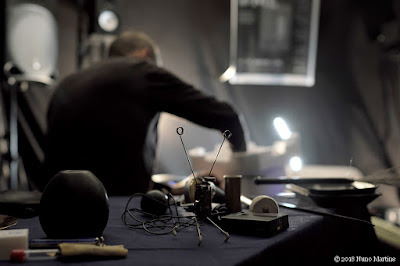 |
Photo (c) Nuno Martins |
Saxophone:
In the early nineties I started taking saxophone lessons with Patrick
Brennan. For the greater part of the decade I focused solely on the tenor;
at the time I was also playing with an indie rock band called Hipnotica, with whom I recorded 2 CDs, also doubling on flute and
the clarinet.
2007 was a year of significant change for me, as I abandoned the tenor and
returned to the electric guitar, beginning to explore the possibilities of
playing two guitars simultaneously. That change is documented in the Variable Geometry Orchestra’s CD, Stills (cs100). My
first solo CD, Nekhephthu, followed in 2008, with the two guitar
combination; at which point I also began playing solo concerts.
Lisbon Scene:
Returning to Lisbon had a huge impact on my listening and playing;
especially due to the music scene that started to emerge from the early
2000s onwards. Through Ernesto Rodrigues’ Variable Geometry Orchestra and his smaller format groups, in
which I participated, such as Suspensão, IKB, String Theory and
the isotope Ensemble, I encountered a fertile environment for
experimentation. As Lisbon became a hub for jazz and free improvisation, I
was also fortunate to play with many visiting artists, something that
clearly impacted both my listening as well as my playing.
The advent of a new generation of extremely well equipped and creative
Portuguese improvisers has been a most welcomed occurrence.
Ongoing projects:
Currently, apart from playing in the various aforementioned ensembles led
by Ernesto Rodrigues, some of the ongoing projects in which I’m involved
include:
- A duo with Wade Matthews (digital synthesis);
- A duo with Patrick Brennan (alto saxophone)
- A duo with Lionel Marchetti (analogue synthesizer)
- Dissection Room trio with Albert Cirera (soprano & tenor sax), Alvaro
Rosso (double bass); - A trio with Maria do Mar (violin), Sofia Borges (percussion);
- Transition Zone trio with Fred Lonberg-Holm
(cello), Carlos Santos (analogue synthesis) - MJAJA
a quintet with Mariana Dionisio (vocals), João Almeida (trumpet), Alvaro Rosso (double bass), João Valinho (percussion) - A duo with performer Lorena Izquierdo
***
Selected Discography
By Abdul Moimême and Paul Acquaro
In this section, Abdul Moimême reflects on select moments in his
discography with additional commentary by Paul Acquaro.
Complaintes De Marée Basse /
with Diatribes (Insub, 2010)
Abdul Moimême: In March 2009 the Swiss duo, Diatribes, including electronics musician
D’Incise and percussionist Cyril Bondi and I played our first trio
performance at the Clean Feed Record store; playing at the Mapping Festival, in Geneva, the following year. In 2011 we tour
in Portugal and southern Europe, culminating in a concert with the Insub
Meta Orchestra, in Strasbourg. Complaintes De Marée Basse is a
product of that collaboration. We later recorded a second CD, Queixas, touring in Switzerland in 2013.
Paul Acquaro: Drums, laptop, percussion large and small, prepared guitars (of course!) and as the CD notes say “metallic objects” – just the ingredients should give you a sense of the final product. From this inventory, you know that the the trio will begin building something with a lot of scraping, clattering and clanging and that the sonic structure the construct will be something never before seen heard. Each track is like a new floor, another layer of creativity, a new arrangement of tones. Track two, ‘Crustaćes,’ becomes beguiling as the tempo increases and the sounds merge, while track five, ‘Entre Les Haut-Fonds,’ is the audio commentary for a tour through the HVAC system, leading to track 6 ‘Pavillon Noir,’ where it all comes tensely together.
– – –
Khettahu /
with Ricardo Guerreiro (Creative Sources, 2011)
AM: At the time, as part of his approach, electronics musician Ricardo
Guerreiro was especially interested in processing other people’s sound,
using this as the foundation of his playing. We worked for a year,
improvising together regularly, culminating in Khettahu, a live
studio recording of improvised pieces.
PA: Real-time re-processing is fascinating. Taking something that in some ways is familiar and turning it into something new and unexpected can yield exciting results. Here we are invited deep into the visceral percussive and vibrating world that Moiméme builds with his two guitars and whatever he has prepared them with. By the middle of track two (#34), it feels like we are outside, blown by wind, sheets of metal clanging around us, and the middle tracks (#29.1, 29.2 and 29.3) are a trek through a barren land of blustery snow and bare tree branches.
– – –
Fabula /
with Axel Dörner, Ernesto Rodrigues, Ricardo Guerreiro (Creative Sources, 2012)
AM: As a follow-up to Khettahu, Ricardo and I invited German trumpeter
and composer Axel Dörner to play and record with us. Violinist Ernesto
Rodrigues joined the trio in this concert, recorded in central Portugal, on
a freezing night in the winter of 2011. Stuart Broomer kindly wrote the
brilliant liner notes. The piece was an improvisation and the quartet was
playing together for the very first time.
PA: Adding the Dörner and Rodrigues to the collaboration between Moiméme and Guerreiro amps up the “unfamiliar” in many ways. Dörner’s own foray into the sonic unknown with his trumpet and electronics can already be a riveting experience. With Rodrigues’ viola, the undulating audio-landscape is filled with flashes of something identifiable, yet still out of reach. At times, certainly in the later third of the recording, the sounds become almost subconscious, leaving more of a feeling of something being there than a distinct memory of exactly what it was.
– – –
Mekhaanu
/
Solo
(Insub, 2013)
AM: Mekhaanu
is my second solo CD and, as in all my solo works thus far, it was totally
improvised, as I like to approach studio session similarly to live
performances. In other words, using the solo context as a laboratory for
experimentation. D’Incise, who had recently created his net label INSUB was amply impressed by the rough mix as to volunteer to
concoct the final mix and master and release it on his label. It’s one of
their first releases.
PA: Moiméme’s liner notes are particular interesting, as he draws contrasts between mechanisms and digitization. For the most part, Moiméme’s work is “analog,” in terms that he manipulates the sounds that naturally come from his prepared guitars and the waves between them and his amplifiers. In his notes, he writes”our daily lives are also permeated by mechanical sounds,” and if we pay attention, we will hear “a territory where wild mechanisms live unbridled by any human restraint.” So, what we hear in this solo recording is the unprocessed guitars and endless variation of sound generation – and for what it is worth, the sounds of a plucked string stands out of the drones, oscillations, overtones, and all out audio assaults.
– – –
Rumor
/
with Marco Scarassatti, Eduardo Chagas, Gloria Damijan (Creative Sources, 2015)
AM: Rumor was the result of our meeting at the MIA improvisation festival, held
yearly in Atoughia da Baleia, Portugal. Marco Scrassatti is a specialist on
Walter Smetak, the Swiss composer and instrument inventor, as well as being
an improviser and composer himself, also teaching music at the University
in Belo Horizonte, Brazil. Gloria Damijan is an Austrian pianist and
Eduardo Chagas a Lisbon based trombonist and improviser. Marco builds all
his instruments and, at the time, Gloria frequently improviser with an
assortment of small objects and the inside of a toy piano. This project was
also a consequence of an invitation, the previous year, to a committee of
Portuguese musicians, by the UFMG University (Minas Gerais), to play in
Brazil.
PA: The opening moments of Rumor instantly have a different feel than the other recordings so far visited. There is the possibility of a melody, of some sort of musical structure, that seems to pervade ‘Improvisation I,’ then about half-way through, Chagas’ trombone can be heard, pushing through the layers of sound. It’s a ghost though, submerging back into the restrained collective drone. Then, there is chiming tone, it too fade away, but each time noticeably suggestive. ‘Improvisation II’ continues with restraint and the feeling that something is lurking, about to happen. About two-thirds through there is a peak of energy that trails off to a exploratory exchange of sounds.
– – –
Exosphere – live at the Pantheon
/
Solo (Creative Sources, 2017)
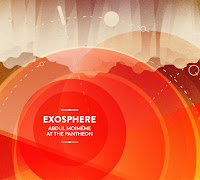 AM: Exosphere results from an invitation by the ‘Escuta Profunda’ festival,
AM: Exosphere results from an invitation by the ‘Escuta Profunda’ festival,curated by João Silva, to play in Lisbon’s pantheon, where amongst the
cenotaphs of various prestigious Portuguese historical figures is buried
the seminal singer Amália Rodrigues. The building is also the culminating
piece of Portuguese Baroque architecture.
The concert was totally improvised as I had no preconceived idea, at all,
of what might be played.
Once again, Stuart Broomer wrote the wonderful liner notes.
PA: Broomer’s notes contain all of the important points needed to navigate this ‘music.’ He discusses the physicality of the sounds, the metallic scrapings, the sonic spaces and the vastness of the landscapes. There is a point where he writes, “there is a sense in which Moiméme’s guitar music is at once epic and abstract, physical and metaphysical, the reimagined instrument itself become projectile … but both its launching mechanism and target are here subject to inquiry…” This incomplete quote sums up for me the haunting and emphemeral (but also so very real and tangible) sounds that Moiméme conjures from his instruments. Eyal Hareuveni also wrote about this work on the Free Jazz Blog here.
– – –
Lisbon: 10 Sound Portraits
/
with Wade Matthews (Creative Sources, 2017)
AM: I believe my liner notes for this work are self-explanatory.
PA: Again, I could hardly offer a better overview of this music than Stuart Broomer does in his article about the making of the source materials of this recording. In my articles about Jazz em Agosto over the past few years, I have indulged myself in writing about my wanderings around Lisbon, a city that really must experienced by foot – as dangerous as that can get on some of those tight, twisting streets. In addition to the sights, there are the sounds, sounds of the waterfront, the aqueduct, the scrape of a historic street trolly as it climbs the hills of the city, and much more. On this album, Moiméme has worked with Wade Matthews to record the sounds of the city – one whose sounds themselves are changing. The resulting recording is a pairing of Moiméme’s sound sculptures with the field recordings, intertwining and becoming their own tone poems.
– – –
Dissection Room
/
with Albert Cirera, Alvaro Rosso (Creative Sources, 2018)
AM: Dissection Room, as the trio is called (formerly AAA) was formed in 2015
and has since then played regularly. Catalan saxophonist Albert Cirera
apart from his outstanding solo work and various formations, has worked
regularly with pianist Agustí Fernandez. Uruguayan double bass player
currently lives in Lisbon, playing with some of the most relevant
Portuguese improvisation groups, including ensembles with violinist Carlos
Zingaro.
PA: One long track, over 53 minutes in total, begins with some blurted notes from saxophonist Albert Cirera. Moiméme’s distinct metallic clangs and warping strings are discernible. We are still waiting to hear from Alvaro Rosso’s double bass … and there it is, a low droning below the droplets of sound. A few minutes and this long standing trio’s individual contributions are congealing into a cohesive, lightly abrasive blanket of tone. Around 10 minutes in the bass is hopping about a bit, while Moiméme is adding reverberating augmentation. Again around the 18 minute mark the interplay, especially between Cirera and Rosso is alight – though still firmly rooted in the atonal sound-world. The intensity ebbs and flows, but the tension is always present, until the recording’s minimalist ending. Of the recordings so far in this list, Dissection Room seems to be the most musically varied. Eyal Hareuveni also reviewed Dissection Room here.
– – –
Terraphonia
/
with patrick brennan* (Creative Sources, 2018)
AM: My association with Patrick dates back to the early 1990 when I was his
student and played percussion in one of the piece of his landmark CD Which Way What. Which Way What was important for Patrick
as it consolidated his career as composer and bandleader but also because
it was, I believe, Acacio Salero’s debut as jazz drummer, an outstanding
Portuguese percussionist who has since disappeared from the local scene.
In Terraphonia patrick and I establish a continuous dialogues,
where the rhythmic and melodic lines of the alto are constantly interwoven
with the rhythmic and textural material of the electric guitars (played in
tandem).
PA: For this one, I’m going to quote myself from my original review here on the Free Jazz Blog: “This is hard to define music, but even when the harshest tones are at play, the duo presents them with care and precision. Brennan compliments Moimême’s sudden tonal attacks with quickly formed ideas, while Moimême fills the silences that the saxophonist’s leave with unexpected sounds. The track ‘gotabrilhar’ stands out, the short track, mid-album, features a buzzing-bee sax and a darkly lit landscape painted by a droning and moaning guitar.”
*spelled in lower case at the musicians request
– – –
Aura /
with Ernesto Rodrigues, Nuno Torres (Creative Sources, 2019)
AM: Aura
is another trio improvised concert with two musician with whom I play
regularly in Lisbon, in the various ensembles led by violist Ernesto
Rodrigues.
PA: This short recording (31:28 minutes in total) is sort of an exercise in self-restraint. The three musicians, Ernesto Rodriques on viola, Nuno Torres on also saxophone, and, of course, Moiméme, blend their respective intruments seamlessly. All of the small sounds, long tones, crunchy textures, whistling tones that make up the bulk of the exploratory concert set reach a knotty crescendo in the final moment of the recording.
– – –
Transition Zone
/
with Fred Lonberg-Holm, Carlos Santos(Creative Sources, 2019)
AM: Carlos Santos (analogue and digital synthesis) and I have an ongoing duo
project where we invite or are invited to play with a third musician. Wade
Matthews (digital synthesis), Wilfrido Terrazas (flute), Emidio Buchinho
(guitar), Mariana Dionisio (voice) and José Bruno Parrinha (clarinets) have all been our partners.
Here we invited cellist Fred Lonberg-Holm to join forces with us. This
improvised studio session was the very first time we played together as a
trio. Since then we frequently play together when Fred is in town.
Rather than a traditional liner note, Stuart Broomer’s text functions as a
conceptual extension of the music.
PA: Quite true, the liner notes are a tone poem themselves. Playing with the sound of the words as they transition from the cardboard sleeve to the readers/listeners mind, and playing with the very words on the cardboard themselves, the notes should be read to the beat-less music with their own cadence. The music – well sound – pulsates with energy. With Fred-Lonberg-Holm providing eviserating, electroncally enhanced cello work, couple with Carlos Santos’ synthesizer, Moiméme is in electric company here. The opening ‘Whirr’ begins without reservation, buzzing, zapping, clattering from the count of … whatever. Follow up ‘Hush’ begins with searing legato notes from the cello and vibrations from the prepared guitars. Crackles of electronic sound emanate from (likely) the synthesizer. As the track continues, sounds stretch like Silly-Putty being stretched to its breaking point. The wealth of sounds and their imaginative application abound on fascinating this recording.
– – –
Ciel-Cristal
/
with Lionel Marchetti (Sonoscopi, 2022)
AM: When Wade Matthews and I played in duo, in the COPLEXA festival (2017),
organized by the Sonoscopia Association, I was extremely impressed by
Lionel’s duo with Xavier Garcia. Providentially, Sonoscopia invited Lionel
and myself to do a residency at their premises, culminating in a concert at
Porto’s planetarium.
See Stuart Broomer’s review of Ciel-Cristal here.
– – –
Livro das Grutas
/
with Wilfrido Terrazas, Mariana Carvalho (Creative Sources, 2022)
AM: My association with Wilfrido dates back to 2016, when we played together at
the Spanish Cervantes institute in Lisbon. Since then Wilfrido has returned
on regular visits and consequently he proposed a studio session, to which
we invited the upcoming Brazilian pianist, Mariana Carvalho, now residing
in Berlin.
See my review of Livro das Grutas here.


